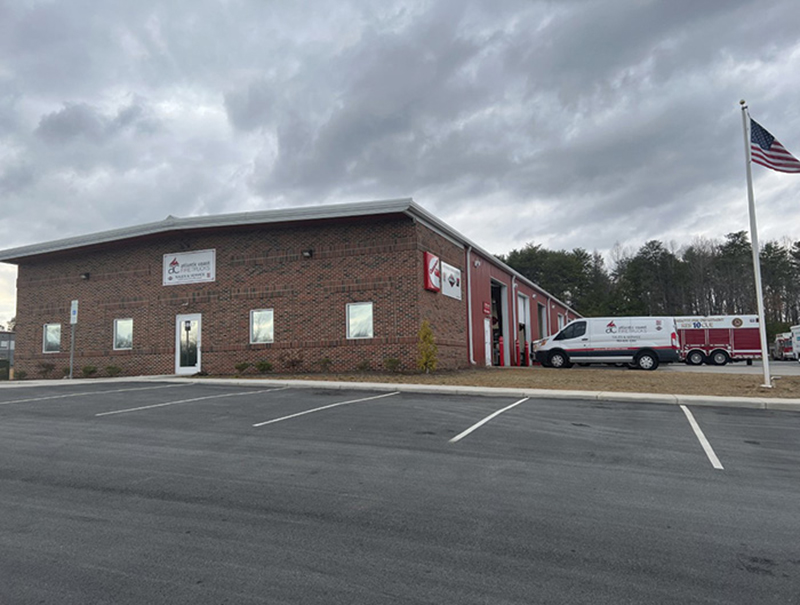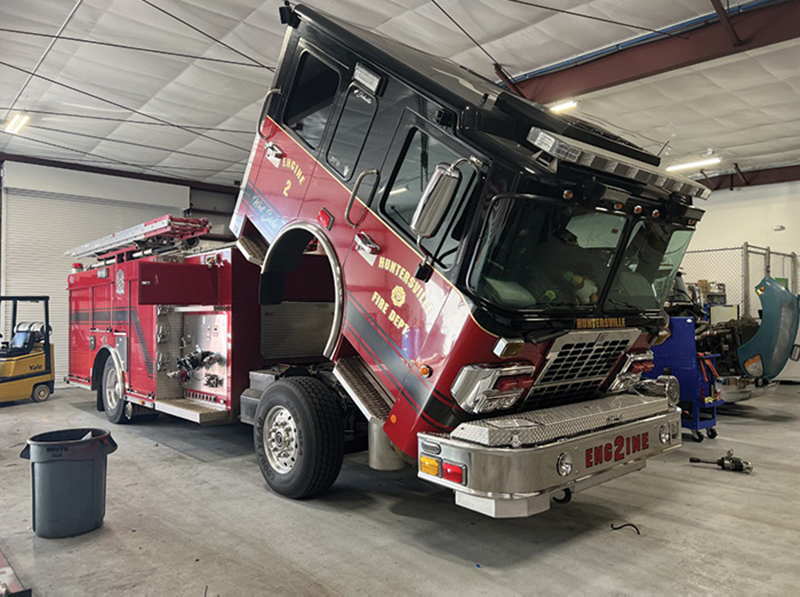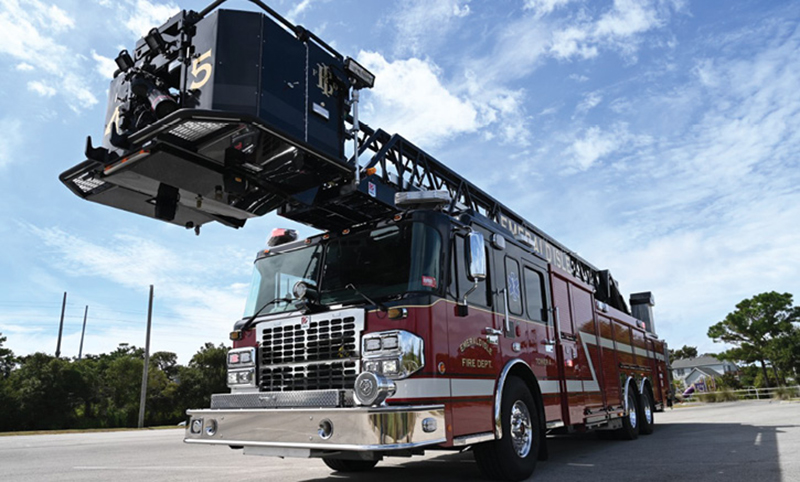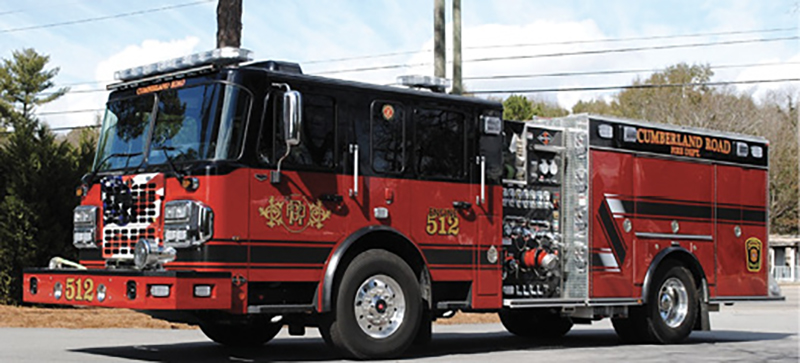By Bill Adams
In 1965, Ernie Dill founded a part-time business in Jackson County, WV, called Mountaineer Supply, selling and servicing fire extinguishers. Several years later, he became one of the founding members, and the first fire chief, of the Silverton Volunteer Fire Department, one of three currently serving Ravenswood, WV.
Ernie’s son, Steven L. Dill, began working part time for his father in 1969 and full time in 1974, primarily demonstrating and selling the original Hurst Jaws of Life®in West Virginia and Eastern Kentucky.
FMC Line Added
In 1970, Mountaineer became a fire apparatus dealer for the FMC Corporation. Steve began selling FMC fire apparatus for his father in 1976, covering West Virginia, Kentucky, and southeast Ohio. In its history, the FMC Corporation has gone by the names of Ford Machinery Corporation, FMC, John Bean, and the John Bean Manufacturing Company. Its original 1884 moniker was Bean Spray Pump Company.
Steve Dill says, “FMC management asked if I would be willing to move to western Pennsylvania and take over the territory that was previously represented by two other dealers. I did. Then, in 1990, what was then known as the FMC Fire Apparatus Division ceased operation, leaving us without a truck line.”
Smeal Line Added
Dill continues, “A brief stint representing another brand did not work well, so we went to the Fire Department Instructors Conference (FDIC), which, at the time, was in Cincinnati, looking for another manufacturer. It was there where we decided to give Smeal a hard look. Myself and my father traveled to Snyder, NE, and met with Don Smeal and his team. It was quite evident after touring the facility the opportunity presented for us to represent an up-and-coming company. We became a dealer in 1993 and, 29 years later, we are the oldest continuing dealership with the Smeal brand.”
Dill’s Fire & Safety
Mountaineer Supply had expanded into selling more and more ancillary firefighting and rescue equipment throughout West Virginia and surrounding states. Steve Dill became its full-time president in 1978. In 1988, Ernie retired, working part time as needed. That same year, Mountaineer’s name was changed to Dill’s Fire & Safety Equipment Company. Twenty-four years later, Dill’s Fire & Safety Equipment Company was sold to longtime Dill’s employee Tony Johnson. It is still in business today. Steve says: “Tony Johnson and I are great friends. I hired him when he was 21 years old.” And Steve Dill is still selling Smeal’s for his own company–Atlantic Coast Fire Trucks, LLC (ACFT).

1 ACFT’s new building in Denver, NC, features six 14-foot-high by 60-foot-long service bays. One of two Spartan/SVI Trucks heavy rescues delivered to the Charlotte (NC) Fire Department is in the background. (Photos by ACFT.)

2 The Huntersville (NC) Fire Department Smeal/Spartan in for service. It has barrier-type cab doors, grip-strut steps, and an overhead ladder rack. It does not have crosslays.
Atlantic Coast Fire Trucks
In 2012, ACFT was founded by Steve Dill in North Carolina, where he currently resides. The dealership recently moved into a new 10,500-square-foot facility at 5867 Balsam Ridge in Denver, NC. It represents Smeal Fire Apparatus, Ladder Tower Company, and Spartan in North Carolina and Tennessee and became an authorized dealer for SVI Fire Trucks in North Carolina and Tennessee in 2018. ACFT sells around 35 to 40 fire apparatus a year. It does not sell ancillary equipment or ambulances.
“We at Dill’s and later at ACFT have sold and serviced Spartan chassis since their inception in 1975,” says Steve Dill. “By the way, FMC purchased the first Spartan chassis. I believe they ordered 15. We started selling Spartan ER when Spartan bought Smeal.”
There are around two dozen employees, and more than half are full time. Steve’s wife, Kristi, works in accounting and his son, Lance, works in sales for the company. Steve Dill says all their salespeople have fire service experience, and three of them retired from career departments. Steve himself has past experience as a volunteer.

3 The Emerald Isle (NC) Fire Department Smeal/Spartan 100-foot, rear-mount platform has a fully enclosed pump house, roll-up doors, a 1,500-gpm pump, a 300-gallon tank, black-over-red paint, and a raised roof.

4 ACFT delivered this 105-foot LTC/Spartan tractor-drawn aerial to the Wake Forest (NC) Fire Department. It is a quint with a 1,500-gpm pump, a 200-gallon tank, hinged doors, and white-over-red paint.
The Market
When asked about the market in general for his sales territory, Dill says his customer base is about 75% career and 25% volunteer. Pumpers account for about two-thirds of sales, followed by aerial devices, tankers, and rescues. Aluminum is the favored body construction. Most career departments prefer, and purchase, custom cabs and chassis but, in some instances, they may have a commercial tanker, mini-pumper, or small rescue or brush truck. Volunteer departments purchase custom chassis in most areas. Custom cabs are usually the extended medium four-door models with five or six seats. White over red is the common paint scheme. Most fire departments have gone to 5-inch large-diameter hose.
Aerials
ACFT usually sells around 10 aerial devices per year—all are quints. There was a time when rear-mount aerials were popular, but mid-mount aerials rule today. Dill says fire departments mostly purchased aerial ladders in the past but in the past couple of years mid-mount towers have become big sellers. Sales are a combination of 105-foot and 75-foot quints and towers. Every few years, they’ll sell a tractor-drawn aerial.
Pumpers
Dill says career departments favor 2,000-gallon-per-minute (gpm) pumps and 500-gallon tanks. Volunteers generally go with 1,500-gpm pumps and 1,000-gallon tanks with dump chutes. Midship-mounted pumps with side-mounted pump operator control panels are most common. ACFT sells very few rear-mounted fire pumps. Most pumper sales feature onboard around-the-pump foam systems. Interestingly, Dill says, “A lot of departments are specifying all discharges coming out the back [assumedly for preconnects] with no crosslays or booster reel above the pump compartment.”
Service
Both in-house and on-the-road fire apparatus services are provided. The Balsam Ridge facility has six 14 feet high by 60 feet long bays devoted strictly to service. Its former leased building only had four bays. Dill says ACFT has 16 employees in the service department; there are five on-the-road service vehicles; the service manager is an EVT master; and most of the other service technicians have a combination of Automotive Service Excellence (ASE) or Emergency Vehicle Technician certification.

5 The Cumberland Road (NC) Fire Department received this Spartan pumper with hinged rescue-style compartment doors, crosslays, and an extended medium four-door cab.
Interview with Steve Dill
Do career departments purchase via competitive bidding or through co-ops?
“Most purchase through consortiums such as Sourcewell Cooperative Purchasing and the Houston-Galveston Area Council (H-GAC).”
How do volunteer departments commonly purchase?
“Most bring in a couple of vendors and pick from there.”
Do many volunteer departments negotiate sales without public bidding?
“Yes, some shop around for price without bidding.”
When fire departments write purchasing specifications, are they usually proprietary, generic, or performance based?
“Proprietary.”
Do fire departments usually write their own specifications or solicit outside help from vendors and consultants?
“Outside help.”
When purchasers use the public bidding process, does the authority having jurisdiction require bidders to “meet the specs” or are they just interested in “low bid” regardless of compliance?
“Most require meeting the specs.”
Have you seen a trend toward multifunction apparatus such as pumper-tankers and pumper-rescues?
“Yes, we sell a lot of pumpers with dump chutes and storage for portable water tanks and pumper-rescues.”
Do purchasers tend to stay with “standardized” apparatus or do they “reinvent the wheel” when they spec rigs?
“Departments like to customize to their particular area and needs. We do sell some standardized pumpers that usually will have customer-tailored options that we install.”
Have National Fire Protection Association (NFPA) 1906 wildland-type apparatus become popular in your territory?
“We have occasionally sold some SKID and flatbed units.”
Do you sell many stock or demo rigs?
“Yes, we order and sell a custom rescue-pumper every year with provisions to add a foam system or dump valve.”
Has there been much of an interest in the “clean cab” concept?
“Some but not overwhelmingly so. Most require replaceable seat covers along with coated interiors for ease in cleaning.”
Has COVID-19 had much of an impact on your business?
“Apparatus sales in 2020 were hit hard by COVID but bounced back well in 2021.”
Do you have any pro or negative comments about the current NFPA 1901 standard?
“No.”
Do you want to make any general comments about your dealer competitors?
“Most are friendly and stay in their lane.”
Do you want to make any general comments about the apparatus industry itself?
“I am very concerned with inflationary pressures and supply line chain issues. If prices for materials/labor keep increasing at current rates, a lot of customers will not be able to afford new apparatus. Customers’ apparatus are out of service weeks at a time waiting on parts.”
The Future
“We have always been an advocate for the customer, and always taking the high road is the core to our success,” says Steve Dill. “I have always been blessed with great and loyal employees. Our sales and service team are constantly faced with challenges from both the manufacturer and customer. ACFT’s proven track record of treating manufacturers and customers fair and with respect gives us the ability to work our way through difficult situations. ACFT has a very bright future and continues to grow. We want to open another service facility in eastern North Carolina and Tennessee. Our road service team has done an outstanding job in all areas. Having a service center closer in some areas would be a great benefit to all.”
BILL ADAMS is a member of the Fire Apparatus & Emergency Equipment Editorial Advisory Board, a former fire apparatus salesman, and a past chief of the East Rochester (NY) Fire Department. He has 50 years of experience in the volunteer fire service.

